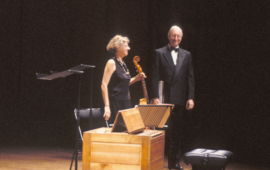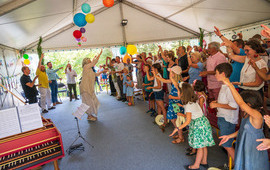He knows William Christie's gardens so well that he has never really left them. Young landscape architect, Alexis Perrocheau tells us about his journey with Les Arts Florissants, from his apprenticeship as a gardener in William Christie's Gardens and his meeting with the master of the place, to his landscape creations in the Quartier des Artistes. An environment rich in beauty, but which faces the environmental challenges of tomorrow...
- How did you discover the Fondation Les Arts Florissants - William Christie and William Christie’s gardens?
Alexis Perrocheau: It was some kind of coincidence. Since I was 14 years old, I have always been involved in the world of gardens and landscapes. During my BTS (French diploma of advanced technician) in Loire-Atlantique, I had the opportunity to do an internship in William Christie’s gardens. This great discovery lasted about a year and since then, I come back almost every summer. At the beginning, they wanted me to help in the garden. Then, as I made new encounters, had new experiences, and started studying as a landscape architect, I was increasingly asked for my opinion on certain subjects, and I was invited to lead the tours of the garden to express my vision and my approach to the history of landscapes. This has been a real support for my professional evolution: I went from the status of gardener - a profession that I respect immensely - to that of landscape architect, which leads me to conceptualize landscapes… even if I remain a gardener at heart! At the end of the day, my career with the Foundation is quite revealing, because I might not have been able to achieve this evolution without its help and that of William Christie.
- What has this experience changed in the way you consider your work and in your vision of gardens?
A. P.: First of all, it changed my perception of what quality means in a garden. During my numerous internships in landscape companies, the emphasis on the aesthetics of gardens and landscapes was not really brought to the forefront. Whereas in William’s garden, the quality really comes first because it is a remarkable garden. This greenspace has a history and is rooted in a tradition of garden work that has been lost. When you walk through different parts of the garden, you really notice its cultural dimension: William wants to transmit an idea of the richness that a garden can give. And I find it very beautiful.
- You imagined projects for the Foundation, such as the "Allée d'honneur" or the Maison In Terra Pax garden; how did you conceive them? And how did you nourish them from your experience with the Foundation and your encounter with William Christie?
A. P.: It was a request from William, so I wasn't faced with a blank page: the idea was to conceptualize and draw his vision. For example, he had in mind a long driveway going from the entrance to a parking lot further on. So my job was to assess what was (or wasn't) possible in terms of space. I based my study on technical criteria, drawings and regular exchanges with William and the technicians. This is an aspect for which I am particularly grateful to the Foundation: it employs very experienced and top-notch professionals who do quality work, and I learned a lot from them. In fact, the working process could be summarized as follows: it is a collective project emanating from a personal will (that of William), which I translate into a visual projection to give it substance. My personal contribution concerns the project’s integration in the landscape that surrounds it. William Christie’s gardens have very strong structures: it is something remarkable and which has its own identity. A garden is in its very-essence a closed space, a micro-universe, but the landscape created by the Foundation must be able to fit with the identity of the village of Thiré.
- As a landscape architect, what would be your creative dream?
A. P.: The projects that I have contributed to in William's gardens have always corresponded to experiments that I would like to accomplish and see succeed. I really like to work on all scales, from gardens to territories. For example, with the "Allée d'honneur", I really liked working on the connection between William's gardens and the village’s landscape. I also appreciate the idea of sobriety, that you don't need to use a lot of elements to give body to the space… an intentional restraint from wanting to say too much.
- The trees in the " Allée d'honneur " make this space an evolving environment that still hasn't taken its final shape. How do you approach working with trees?
A. P.: Working with trees is something extremely hard and fascinating at the same time. Hard, because they have time scales that are beyond us. A tree can live two, three, five hundred years. And I have a very clear image of William telling me: "You know Alexis, these projects are for a hundred, two hundred years". I was aware of that and so I have selected tree species that are extremely resistant to drought. That is very important because Thiré and a large part of western France will experience more and more drought episodes. We are also trying to understand the dynamics found in natural environments in order to reproduce them by adapting them to our artificial systems - and I find this fascinating! This two-way process is really important, especially in a context of global warming.
- How do you see the future of your profession in the context of climate change?
A. P.: The profession of landscape architect is actually quite recent. There have been gardeners for a long time who have designed gardens, like Le Notre for example. But the idea of public space and qualitative restoration of a landscape really started to emerge in the 19th century, mainly at the time of massive industrialization. It is a profession that emerged to counteract the excesses of urbanization and industrialization. Ultimately, "landscape" is a term that has no single definition and continues to evolve. But to me, it is the most Human form of "Nature". Given the fact that we are more and more numerous on earth, I think that landscape architects can play a role to accompany these transformations of landscapes. It is a profession of the future: we will have to create more and more fresh environments in urban areas for example. We will probably need to change our public spaces to face the rapid climate change and make forecasts on future changes in our urban spaces but also rural landscapes with other specialists such as climatologists, sociologists... For me, this profession is also a kind of extension of my parents' profession as farmers, who have been the first men to have shaped and transformed the land. And I find it rather beautiful.











